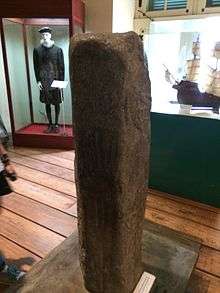Luso-Sundanese padrão
The Luso-Sundanese padrão is a padrão commemorating a treaty between the kingdoms of Portugal and Sunda, better known as the Luso-Sundanese Treaty of Sunda Kalapa.[1]

History
Because of the growing Islamic force in Demak and Cirebon, the Hindu king of Sunda, Sri Baduga, sought assistance from the Portuguese at Malacca. He sent his son, Crown Prince Prabu Surawisesa, to Malacca in 1512 and again in 1521, in order to invite the Portuguese to sign a peace treaty, to trade in pepper, and to build a fort at his main port of Sunda Kalapa.[1] By 1522 the Portuguese were ready to form a coalition with the Sundanese king in order to gain access to the profitable pepper trade.
The commander of the fortress of Malacca at that time was Jorge de Albuquerque. In 1522, he sent a ship, the São Sebastião under Captain Henrique Leme, to Sunda Kalapa with valuable gifts for the king of Sunda. Two written sources detail the concluding of the treaty: the original Portuguese document of 1522, with the text of the treaty and the signatures of the witnesses; and João de Barros’s report in his book Décadas da Ásia, printed after 1777 or 1778.
According to these sources, the Portuguese were welcomed warmly by the former crown prince, now King Prabu Surawisesa Jayapercosa (or King Surawisesa of Pajundan, also called Ratu Sang Hyang, Portuguese Ratu Samian); Barros called him King Samião. The Portuguese were allowed to build a fortress at the mouth of the Ciliwung River where they could load black pepper to their ships. The King also pledged to give one thousand sacks (more than 20 tons) each year to the Portuguese. The treaty was executed in two copies, one for the king of Sunda, one for the king of Portugal; each was signed on August 21, 1522. The Sundanese king's deputies were the chief mandarin Padam Tumangu (Honourable Tumenggung), the mandarins Sangydepaty (Sang Adipati) and Benegar (Bendahara or treasurer), and the shahbandar (harbourmaster) of the land, named Fabian.[2]
"On the said day", these mandarins and other honorable men, together with Henrique Leme and his entourage, went to the mouth of the river where the fortress would be constructed, on the "land called Sunda Kalapa". There they erected a memorial stone, called a padrão, in what is now the Tugu sub-district of North Jakarta. It was a Portuguese custom to set up a padrão (memorial stone) when they discovered a new land. The padrão, now called the Luso-Sundanese padrão, is kept in the National Museum.
Because of troubles in Goa, Portuguese India, the Portuguese failed to keep their promise to come back the following year to construct the fortress. They did not return to the Java Sea until November, 1526, when they arrived in six ships from Bintan under the command of Francisco de Sá.
The padrão was rediscovered at the junction between Jalan Cengkeh and Jalan Kali Besar Timur in 1918 when the Dutch East Indies government made a reclamation in this area.[3]
Details

The Luso-Sundanese padrão is a 165 cm high stone pillar. The upper part of the padrão shows an armillary sphere, a symbol of discovery used by King Manuel of Portugal. On top of the sphere is a trefoil. A cross of the Order of Christ has been carved above the first line of the inscription.[4] The inscription itself, OSPOR .ESFERЯa/Mo is an abbreviation of O Senhor de Portugal. Esfera/Espera do Mundo, meaning The Lord of Portugal. Sphere/Hope of the World.[5]
References
- Zahorka, Herwig (2007). The Sunda Kingdoms of West Java, From Tarumanagara to Pakuan Pajajaran with Royal Center of Bogor, Over 1000 Years of Propsperity and Glory. Cipta Loka Caraka.
- Alguns documentos do Archivo Nacional da Torre do Tombo ácerca das navegações e conquistas Portuguezas (in Portuguese). Imprensa Nacional. 1892. pp. 460–461.
- Lilie Suratminto (2011). Creol Portuguese of the Tugu Village: Colonial Heritage in Jakarta Based on the Historical and Linguistic Review (PDF). 3. International Journal for Historical Studies. Archived from the original (PDF) on 2017-04-07.
- "Sejarah Singkat KAJ" (in Indonesian). Keuskupan Agung Jakarta. Retrieved 19 January 2018.
- Heuken, Adolf (2000). Historical Sites of Jakarta. Cipta Loka Caraka. p. 24.